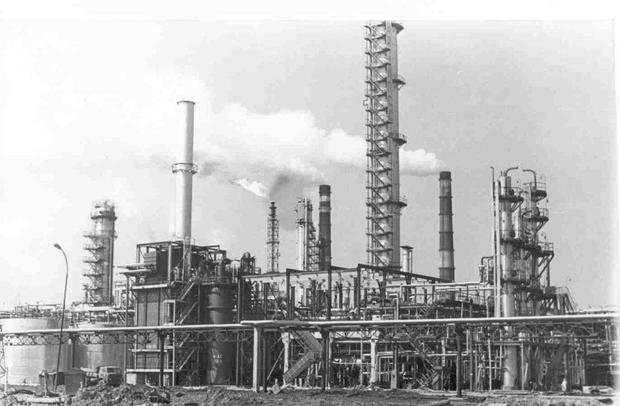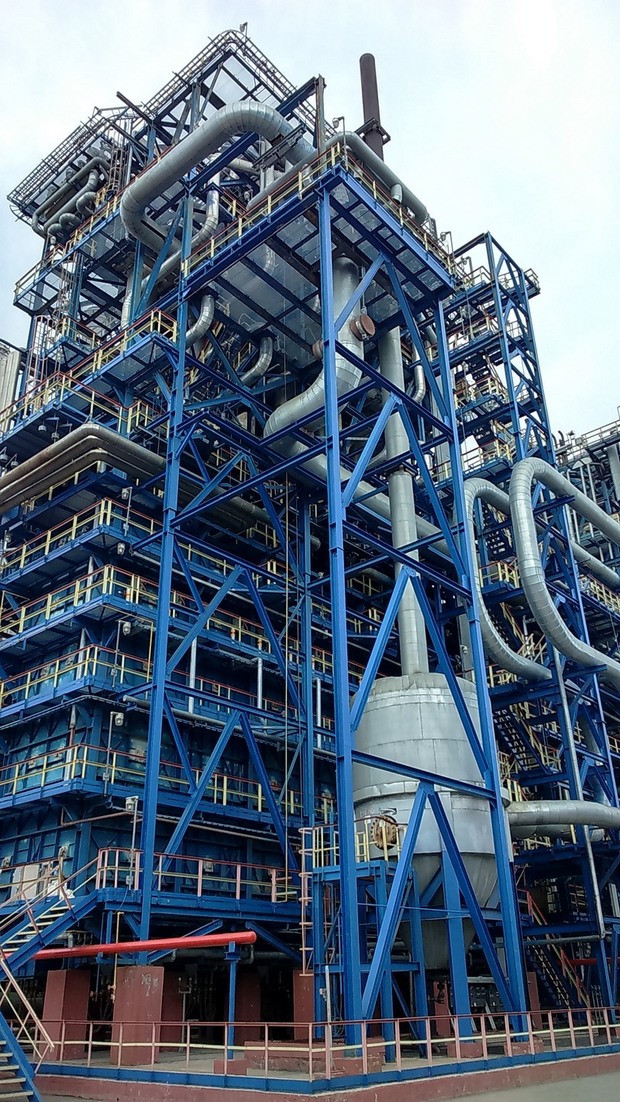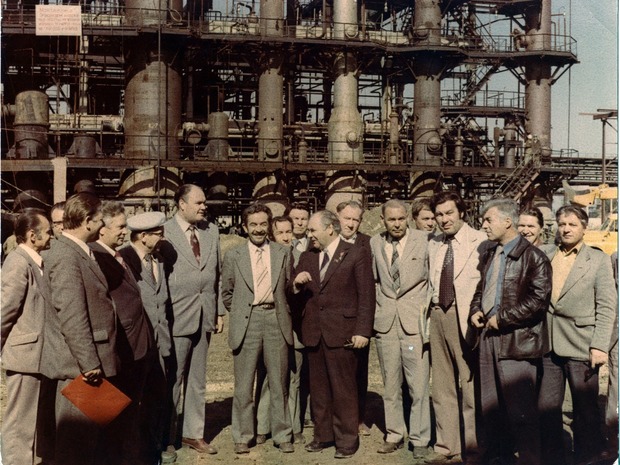Driving force of Nizhnekamskneftekhim
The ethylene production in Nizhnekamskneftekhim PJSC can rightly be called a strength of the company. It is so-called basic pertochemistry. In late August, the unique ethylene complex celebrated its 40-year anniversary. Today and since its foundation in 1976, there is no other productions with such capacity in Russia. About the significance of olefins, about how it all began, the present day and prospects for the production of ethylene in Nizhnekamskneftekhim – in the article of Realnoe Vremya.
The most difficult one…
'We were launching using a hit-and-miss approach, learning from mistakes. Although the staff was big, nearly a thousand people, but the experienced specialists, so to say, the 'titans of thoughts', were not enough,' said a veteran of the plant Yury Spiridonov, who joined the Nizhnekamsk chemical plant in September 1975, recalling how the plant was launched.
The Nizhnekamskneftekhim ethylene complex is a unique production. It was called unique in the 1970s due to the fact that the scale of production did not correspond to the output volume: the design capacity of the plant at 450 thousand tonnes exceeded multiple times the only production of ethylene in Salavat, the Republic of Bashkortostan, and all the plants of the industrial complex located on the site at just 250 thousand square meters.
Everything began in the late 1960s from the contract signed between the all-Union association Tekhmashimport and the Toyo Engineering company to design and supply equipment for the ethylene complex. The decision to build a complex for the production of ethylene, propylene, butadiene, benzene and other related products in Nizhnekamsk was adopted at the highest level — the CPSU Central Committee and USSR Council of Ministers — in December 1970. In 1973-1974, a large-scale construction was launched on the territory of the chemical plant, and in June 1976 the first commercial ethylene was obtained.
The peak of works was in 1975: the construction site resembled a large anthill, it was densely filled with cranes and people, the number of builders and installers at times reached 9 thousand people a day. The plant was built in a short time: the installation of main equipment took only 14 months, but from the originally scheduled start date to the actual start of the production into operation 8 months passed.

The launch was very hard, note people who participated in it. The main problem was largely associated with the lack of experienced specialists, although the mechanics and technologists from all over the Union came to the object. It was planned to launch the major ethylene complex in the country as usual by next anniversary of the October Revolution, which was celebrated on 7 November. 'However, we did not launch on the November holidays. Perhaps, it was right decision: the winter was severe, and the Japanese, as it is known, are very scrupulous, that is why we tried to do everything perfect. So we prolonged until the mid-May, we were launching very tediously and hard. Perhaps, the Japanese also did not have enough experience to put us on the right track,' told Yury Spiridonov.
The compressors of the Japanese company Mitsubishi added a lot of problems in this start-up period. They were launched by the sent to Nizhnekamsk specialists from the ethylene plant in Salavat, when the Japanese engineers went home, late at night. 'The Japanese come — the equipment works. We launched and immediately stopped. In general, there were many shutdowns in those years, turnover at the plant was high, many could not withstand such pace,' tell those who have been working at the plant since its foundation.
'The difficulty was the language barrier, there was a lot of technical instructions in Japanese, so, first, it was translated from Japanese into English, then from English into Russian. Now you read these instructions — such a nonsense is written, but still we had to launch the plant,' said Spiridonov. As a result, the backbone of the plant was formed, there were leaders, senior operators and operators who put all process documentation in order.'
'Even Lenin did not write such amount of volumes as Gennady Ivanovich wrote various regulations on management of technological process,' Yury Spiridonov makes joke of Gennady Shunin, with whom side by side he was working from the day of commissioning of the plant. 'God forbid, anything accidentally falls on foot, there will be a fracture.'
On 21 June 1976, an event occurred, which the company workers and the whole country waited for almost three years – the first product ethylene was obtained. The veterans of the plant remember that day with a smile, 'first obtained ethylene was loaded in the bags'. The acceptance document of the ethylene production in operation by the state Commission was signed on 31 August. This date has become the official birthday of the plant.
However, the plant entered the stable regime only in the mid 1980s. With a design capacity of 450 thousand tonnes, the plant produced 200-300 thousand tonnes of ethylene per year, as the Nizhnekamsk chemical plant by that time was not ready to recycle almost half-million volume of olefins. Therefore, almost all ethylene was sent to Kazan Orgsintez to obtain a plastic film. Today, each tonne of ethylene and other pyrolysis products produced by the plant is as valuable as gold.
For four decades, since the commissioning of the plant into operation until today, the ethylene complex of Nizhnekamskneftekhim PJSC produced more than 16 million tonnes of ethylene, about 8 million tonnes of propylene, more than 2 million tonnes of butadiene and more than 6 million tonnes of benzene.
Through fire, water and copper pipes
'The formation and further development of ethylene is the formation of a generation of ethyleners, as they say at Nizhnekamskneftekhim. As the production of ethylene is very difficult, says the production director Ilgiz Yarullin, who came to the plant in the early 1990s, then the staff here are very competent, especially engineers who teach the youth the basics of the technological process who came here after colleges and universities. A lot depends on the operators, they are required very high standards at the plant.'
How to deal with these stringent requirements if you have to serve the main equipment of the complex — ovens, the temperature inside of which reaches 1200 degrees, and at the workshop, where the compressors work, on the contrary, it it cryogenic cold of 160 degrees below zero. In addition to all of these, light hydrocarbons, with which with installation columns are filled – are dangerous, flammable products.
Today, the average age of the staff of the plant, consisting of 565 people, is 36 years. In recent years there has been a significant rejuvenation — the average age has decreased by four years. The trend was set in 2003, when the Director General of Nizhnekamskneftekhim Vladimir Busygin entrusted the management of the most difficult plant in the enterprise to the 34-year-old Azat Bikmurzin, who was in charge of one of the shops. Then he became the youngest plant director in the history of the company. Many questioned: 'Will he handle? Can he bear the load?' But he did handle with dignity and even more — from 2014, Azat Bikmurzin heads one of the country's largest petrochemical companies.
Before Bikmurzin, Khamit Gilmanov headed the plant for many years, who started here from the chief mechanic. He then became the chief engineer and first Deputy Director General of Nizhnekamskneftekhim. He was replaced by other former ethylener — Ilfat Sharifullin, passed a way from an operator of compressors, the head of the unit, the head of the shop to the director of the ethylene plant.
As the current director of the complex Ilgiz Yarullin stressed, 'our plant is a real source of manpower. Here, the employees pass through fire, water and copper pipes.'
The plant is famous for their family dynasties. One of them is the Zakirovs, father and two sons. Having employed in the middle 1970s in the ethylene plant, Galimzyan Zakirov did not even think that his choice would be decisive in the fate of the whole family. Here he met his love, had a family, had two sons. Both chose the petrochemical profession without long and painful hesitation. Before their eyes there always was a shining example of their father. 'Here at the plant, you cannot become an equipment operator in one year. They become only in 3-4 years,' emphasizes the complexity of the production its director.
If earlier at the factory much depended on a person, the problems that arose now are neutralized by the modern technology — a machine thinks instead of a person. 'There are such machines that do not allow to err if staff produces incorrect actions,' said the old-timers of the production.
The age of digital machines, microprocessor control system came to the plant along with the modernization of the main equipment — ovens. The latest technology of Japanese company Yokogawa has made the technological process more reliable. Before, it was led by pneumatic devices, panel control system. The staff had to keep in mind all the options, and sometimes the human factor played here not the best part. Now the smart machines tell you where the failure occurred.
Focusing on increase
The cornerstone — any petrochemist-professional would tell this about ethylene. This product is a kind of derivative for the manufacture of hundreds of other petrochemical products. Today it is in demand as never before. The volume of ethylene production in Russia is two times less than even in Iran.
In the 1970s, the ethylene complex of Nizhnekamsk chemical plant was conceived as a giant in those days production at a capacity of 450 thousand tonnes per year. However, many years the petrochemistry workers were not working on these loads. So much ethylene was not required.
It was until the late 1990s. Then the company's management adopted a number of strategic decisions aimed at increase of production of main types of products — rubbers and a number of monomers. Especially in the framework of the development strategy, the company was planning to transit from production of monomers to polymers, involving the construction of plants for the production of plastics — polyethylene, polypropylene, polystyrene. The fundamental raw material in the production of which there were the products obtained at the ethylene plant. There were already not enough available in the production volumes of olefins.
In 2001, it was started the next modernization and reconstruction of the ethylene complex of NKNK. The aim was ambitious — to reach an annual volume of 600 thousand tonnes of ethylene. For its implementation it was attracted the American company ABB Lummus Global. In the framework of the developed program they were going to replace almost all ovens and other significant technological equipment. Almost every year a new equipment was included in the production chain — pyrolysis oven, compressors, turbines. Various plants were installed.

The modernisation of the plant was carried out without the cessation of production. The most difficult part was to place the new equipment and to reconstruct the existing at such small area, especially the terms for the carrying out of major repairs were very short. As the director of the plant Ilgiz Yarullin noted, 'here it is impossible just to stop the plant and to change equipment. This can be explained, first of all, due to the high demand of ethylene and propylene.'
Overhaul after overhaul, the petrochemical workers upgraded equipment of the ethylene complex. New technology nodes appeared on the site. Modernization was gradual and lasted nearly 10 years.
The first result from the modernization of the plant was reached in 2005, when it was obtained the record-breaking for 30 years of the enterprise production output: 465 thousand tonnes of ethylene and 203 thousand tonnes of propylene. In 2010, the plant reached a new level — nearly 593 thousand tonnes of products and 13 million tonnes since the start of production. And, finally, a year later, in 2011, the plant passed the coveted milestone of 600 thousand tonnes of production, which it was seeking since 2001.
During this time, six new pyrolysis ovens were built on the territory of the complex: two gas ones, the other — for pyrolysis of gasoline and butane. Moreover, the design of each was made specifically for Nizhnekamsk ethylene complex. By the way, first in those years in Russia oven of the type SRT-6 was mounted and started in manufacture at Nizhnekamskneftekhim.
The increase in ethylene volume contributed to the build-up of other types of products for the NKNK. As the Chairman of the Board of Directors of Nizhnekamskneftekhim Vladimir Busygin noted in an interview, 'ethylene is the heart of all our plant. It is impossible the production of ethylene without the production of polyethylene, polypropylene, rubber — first of all, the build-up of rubber. Without factions, which receives the plant, there would not have been such production increase of GBK and BK.'
Meanwhile, the plant is planning to build two more ovens of pyrolysis. Besides, one of the important problems today — to increase benzene production, which is in demand in the factories of styrene and polyester resins and other productions of Nizhnekamskneftekhim.
In one united technological chain
It is impossible to see and touch ethylene — it is a colorless gas. It was first obtained in 1680 by a German chemist Johann Becher. Today, ethylene is the most produced organic compound in the world because it is one of basic products of industrial chemistry. Ethylene is not found in natural gas, so the industrial method for its production was established. It is formed by the complex decomposition of hydrocarbons at high temperature in ovens.
Of course, the most impressive sight for a person, far from petrochemistry and first came to the plant's – it is pyrolysis ovens. Huge, at height more than 40 meters, they are major part of the technological process of ethylene production. At a temperature of 850 degrees, straight-run gasoline is divided on the component parts.
New ovens, mounted in the framework of modernization of the plant, from the point of view of technology, are high-performance, highly selective and 'flexible', they can run on both gas and liquid feedstock – straight-run gasoline.
In the chain, consisting of nine plants of Nizhnekamskneftekhim, the ethylene production is, in fact, the head. It is a raw material source, without which any other plant cannot function. Here the necessary for the production of rubbers butadiene and isobutylene fraction, ethylene and propylene for production of plastics are produced. '100% of products are in demand and are not accumulated in the warehouses,' says about the importance of its production Ilgiz Yarullin. Today, the product mix of the company consists of 120 items and nearly all have a share of products produced at the ethylene plant.
The plastics plant is, perhaps, the most active consumer of olefins: it takes the lion's share of ethylene and propylene, out of which the polymers of ethylene and propylene are produced. In addition to its own provision, the products are the raw material for production of Kazanorgsintez, it is sent by ethylenpipe to Bashkortostan — Ufa, Salavat and Sterlitamak.
However, before reaching the consumers, ethylene passes through a complex production cycle. It is about 100 different technological processes, each of which has its own peculiarities. If at least one of the links fails, the entire process chain destroys.
Ethylene of the future
Further development strategy of the petrochemical flagship of Tatarstan is connected with the implementation of the project on the construction of a new ethylene complex and integrated plants for the production of the most popular types of plastics. By its scale it will be, in fact, the third industrial zone of Nizhnekamskneftekhim.
During the visit to Nizhnekamskneftekhim PJSC in April of this year, the President of Tatarstan Rustam Minnikhanov called the olefin complex 'the main task for the company and RT, because the company is a growth point in the Kama cluster in petrochemistry and oil refining'. He noted that development of ethylene requires plastics. 'The construction of ethylene complex is the top priority program of the Kama cluster,' said the President of Tatarstan.
As for the future of the ethylene plant, operating already for 40 years, the annual output of 610 thousand tonnes, which has been reached, is the maximum, said the director of the complex Ilgiz Yarullin. Therefore, the management of the company made a strategic decision to build the new complex. However, the new olefin complex will not replace existing one: together with Nizhnekamskneftekhim it will get by 2026 almost 2 million tonnes of ethylene. The rich experience of the ethylene plant already serves as a support in solving of the pressing issues related to various technical issues during the implementation of the main project of Nizhnekamskneftekhim.
